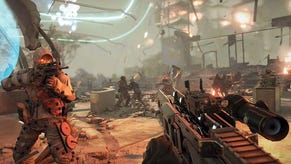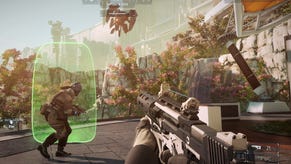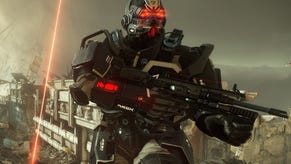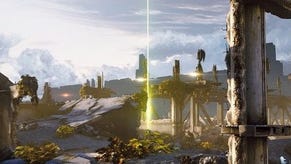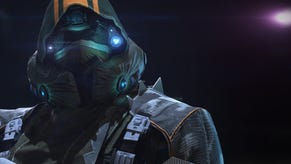Killzone Shadow Fall review
Vekta graphics.
Making the flagship launch game for a new console - a role Killzone Shadow Fall plays for PlayStation 4 - can be a make-or-break moment for a game developer. The opportunity is immense: the world's eyes will be on your game. But there are risks too. You need to make the game on a tight schedule, to a hard deadline, and on shifting technical sands. You're going to have to cut features and corners; the game is probably not going to be quite what you wanted it to be. Just ask Bungie how right this can go. Just ask Rare how wrong.
To its credit, Guerrilla Games seized this opportunity with both hands. The Amsterdam team gave themselves just two and a half years to make a game that would not only show the world what PlayStation 4 could do, but rethink what a Killzone game could be. It was a lot to take on, and something was bound to give. It has. However, the result is still a solidly enjoyable and technically outstanding debut for the new system. Take a bow, PS4.
If Guerrilla has let itself down a little - only half-delivering on its brief for a more involving story and game design - then at least it has done Sony proud. If you want to give your new console a thorough workout, this is the game to get; there is clear water between it and even the best of the multi-format games. We can talk numbers: it runs at a native 1080p resolution and at 30 frames per second in the campaign, 60 in multiplayer, with not a hint of screen tear or judder or slowdown, and just a little texture pop-in. Or we can talk feel, which is knife-sharp and rock-solid. Guerrilla's technicians have made this machine sing.
Alongside the technology is the craft. The fidelity of the artwork is eye-watering in places; a narrow alley in a shanty town can be just as breathtaking in its detail as the vertiginous, aerial establishing shot that runs under the credits. What you really notice is the lighting - dear God, the lighting. The PS4 has unthrottled the artists' access to this art and they have run amok, drenching every corner of the game in luscious sunsets, glistening reflections, glaring lens flare and richly coloured, mote-filled shafts of neon. It's not subtle, but who cares, it's gorgeous - and it gives even the game's smaller-scale locations and more intimate moments a glossy, opulent air. Unlike the bombastic Killzone 3, Shadow Fall doesn't have to go big to wow you.
That's consistent with the game's setting and tone, which swap wartime grit for tension and intrigue. The Killzone saga has so far been a straight take of World War Two in space, with the fascistic Helghast and their orange goggles filling in for the Nazis; now Shadow Fall jumps us forward three decades to a Cold War. With their home planet destroyed, the Helghan people have struck an uneasy truce with the Interplanetary Strategic Alliance and made a home alongside their former enemies on the lush consumer paradise of Vekta. Vekta City is now a clear analogue for Berlin, divided by a giant wall - although it's best to drop the comparison there, since as genocide survivors, the Helghans now seem to be representing Jews, Soviets and Nazis all at once. (An alternative reading of Vekta City as Jersualem isn't any more comfortable.)
It doesn't bear close examination perhaps, but it's still a setting rich with visual and thematic potential, which Guerrilla is initially keen to exploit. The artists draw a striking contrast between the Vektans' spires of curving glass and the Helghans' canyon-like container cities, between propaganda and advertising logos. The writers play it with a touch of even-handed Euro-cynicism, too. Although you play Lucas Kellen, an ISA Shadow Marshal - a blend of spy and super-soldier - the storyline is as keen to expose the ISA's double standards and dirty tricks as it is the Helghans' cruelty and dogma.
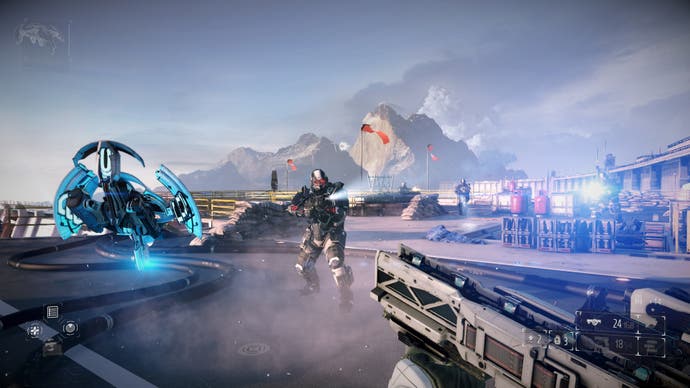
It's not done with any great subtlety, but it makes a change from the usual unthinking militarism. The problem is that Killzone isn't Killzone if you're not shooting Helghast troops right between the glowing orange eyes, and so the scenario keeps having to contort itself to make a more nuanced worldview fit this old black-and-white antagonism. A terrorist faction called the Black Hand is constructed as a convenient bête noir, but the line between it and the Helghan authorities is first fudged and then practically erased. If it looks like a bad guy, it's probably a bad guy. Still, the ending - do keep watching the credits, by the way - offers a neat reversal and leaves things interestingly aligned for future instalments.
A bigger issue, perhaps, is Shadow Fall's willingness to leave Vekta City behind. An early mission into space to destroy an unpleasant ISA research facility is fun - a kind of Dead Space-flavoured palate-cleanser - but when Shadow Fall escapes the gravitational pull of its compelling setting a second time, it's for good, and not for the better. The game loses its grip on its own identity and winds up free-floating through a world of sci-fi action cliché, of shiny steel corridors and set-pieces that are frustrating, shallow and poorly conceived. One late location is a stunning visual idea that resolves into a disorienting and featureless trudge; the enemy base from the final level proper could appear in virtually any game. Ironically, if Shadow Fall had kept its feet on the ground, it would have been much less pedestrian.
It doesn't follow through on all its early gameplay ideas, either. Guerrilla wanted to make a more tactical, flexible and deep game than previous Killzones, with more open level design. The second chapter, The Shadow, is a perfect demonstration of this idea.
After a quick, dark sneak makes the case that stealth is a semi-viable option in this game, you're thrust into a large, open wooded area, full of sniping spots and secret routes, and surrounded by various mission objectives. You have to tackle these in order, but you have genuine options when it comes to how and from what direction. The level also introduces your OWL drone, a useful tactical device which can be commanded to stun enemies, attack them, erect a shield for you or run a zipline down to a lower point (a great way to get around, which reminded me of Dishonored's Blink skill in the way it opens up first-person navigation).

After years of shooters in which all your targets lie ahead, this open battleground - clearly heavily influenced by multiplayer map design - takes some getting used to, especially when hitched to Killzone's typically no-nonsense difficulty. Once you are used to it, it's thrilling and instantly replayable, as you seek out new routes and alternative encounters. But Shadow Fall never throws up anything like it again.
There are flashes of this philosophy here and there throughout the game: a scattering of sneaky vents, secret vantage points and open plazas. A hostage situation at the end of the fourth chapter, set in a circular building with multiple entry points and destructible walls, is brilliantly realised. But true tactical options soon dry up, and levels quickly devolve from non-linear spaces into elaborate, broad corridors - and then into simple, narrow ones. There are a lot of rusting gangways. Eventually, you realise that you haven't even thought about using that lovely zipline for a level and a half.
Did Guerrilla run out of time, of conviction, of ideas? I'm not sure - and I also don't want to overstate the impact on the game. As a straight-ahead shooting gallery, Shadow Fall is still muscular and confident, with that signature Killzone weight to it, all deliberate reload animations, thudding slides into cover and punchy, every-bullet-counts impact. The OWL remains a fun tactical toy throughout - especially its fire mode, which can be used for distraction, suppression or defence. It's a good game, but it's not the game the opening levels sold you. Blame the strictures of making a launch title, I guess.

When it comes to multiplayer, Guerrilla has shown some cheeky ingenuity in getting around those strictures by offloading some of the work onto players. Lacking the time to hone enough game modes to perfection, it has honed their component parts instead and offered these to players to do what they like with in heavily modified Custom Warzones. At this early stage it is impossible to tell how this will work out, but the structure is clever and the signs are promising.
Regardless, the quintessential Killzone experience endures in Classic Warzone, a distinctive and hugely entertaining team mode that, over the course of a single long-ish match, cycles randomly through variants of capture the flag, map domination and an assault mode where bombs need to be primed and disarmed. It's terrific stuff that promotes solid team play and quick thinking, and like the Custom Warzones, it's based on strong foundations.
The maps are tight and easy to learn, with plenty of elevation and stealth approaches and a tendency to avoid singular choke points. The standard class archetypes - assault, support and scout - are clearly defined and enlivened by special abilities borrowed from the OWL alongside a few new ones (the support class's ability to set respawn beacons is a real match-turner). All core weapons and abilities are unlocked from the start, and the XP grind is sidelined - instead, a series of skill challenges rewards you with weapon modifications and the like. The guns themselves handle beautifully, although in both campaign and multiplayer, Shadow Fall suffers from a lack of variety and imagination in its armoury that's especially disappointing in a sci-fi game.
"Shadow Fall sets up an open-ended tactical shooter in a cynical world of sci-fi realpolitik - and then bottles it, taking a suicide mission into empty spectacle"

Nine years ago, the first Killzone game offered us an unforgettable, iconic image: a gas-masked space Nazi, eyes glowing a malevolent ochre, standing under a cherry blossom tree. A strong start - and yet since then, the series has been groping for an identity that could live up to that look and set it apart from its FPS peers. It's never quite found it.
It's all the more frustrating that Shadow Fall fails to establish that identity, because it gets so close in its early design and themes. It sets up an open-ended tactical shooter in a cynical world of sci-fi realpolitik - and then bottles it, taking the easy escape route of another suicide mission into empty spectacle. There's a lack of confidence here that contrasts starkly with Guerrilla's dazzling, sure-footed command of the new hardware. It's a game that any new PlayStation 4 owner will be proud to show off - but it won't be one they remember by the time PS5 rolls around.



